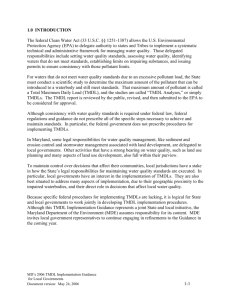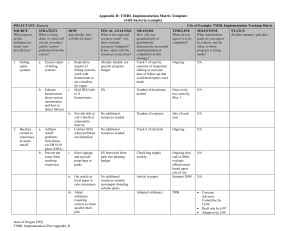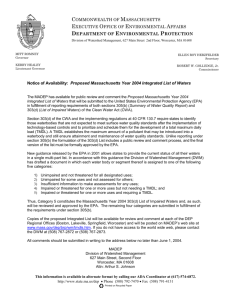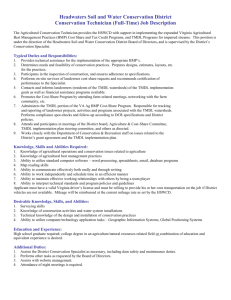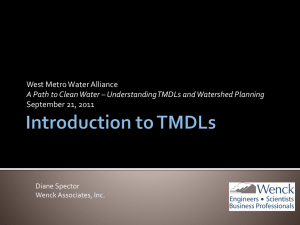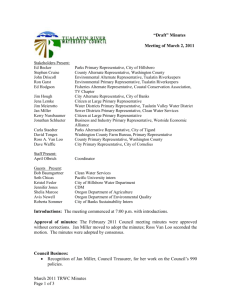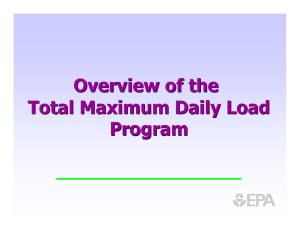Developing a Total Maximum Daily Load (TMDL) for the Wisconsin River - Ann Hirekatur, WI Dept. of Natural Resources
advertisement
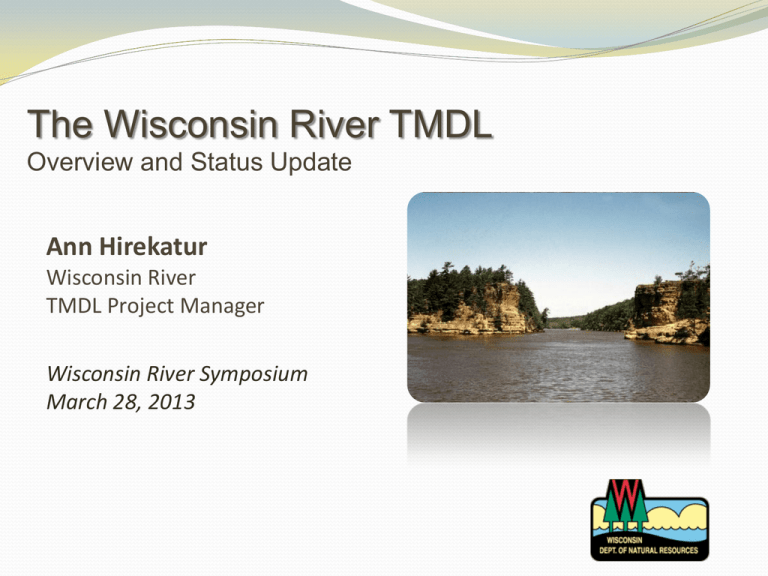
The Wisconsin River TMDL Overview and Status Update Ann Hirekatur Wisconsin River TMDL Project Manager Wisconsin River Symposium March 28, 2013 Why develop a TMDL? Baseline Pollutant Load Total Maximum Daily Load Does not meet water quality standards Meets water quality standards Developing a TMDL Baseline Pollutant Load ? TMDL Load What is the magnitude of the Total Maximum Daily Load for each subwatershed? Developing a TMDL Baseline Pollutant Load ? ? ? willTMDL the TMDL be WhatHow is the for each apportioned water body? among loading sources in each subwatershed? Total Maximum Daily Load The amount of a pollutant a water body can receive and meet water quality standards Background Load • Naturally occurring from wetlands, forests Non Point Sources (Load Allocation) • Agricultural runoff • Non-Permitted MS4s Point Sources (Waste Load Allocation) • Municipal Wastewater • Industrial Wastewater • Municipal Separate Storm Sewer Systems (MS4s) TMDL Load Allocation + Waste Load Allocation + Margin of Safety How did we get to a Wisconsin River TMDL? 2001 WDNR/USACE develop joint TMDL monitoring proposal for $1.5 million. Proposal not funded 1995 2009 – 2013 WNDR receives Section 22 Planning Assistance from USACE Wisconsin River TMDL Monitoring 2008 First Pontoons and Politics at Petenwell Castle Rock 2000 2005 2010 2015 2009 1996 Petenwell Castle Rock Comprehensive Management Plan 2010 State legislature appropriates $750,000 ($150,000/yr. for 5 years) for monitoring upstream of Castle Rock 2004 WDNR proposal to USEPA for river water quality monitoring. Proposal not funded Wisconsin River TMDL The Wisconsin River TMDL Study Area Wisconsin River TMDL Development Steps Monitoring Conceptualization • Civic Engagement Draft TMDL Internal Review Public Comment Modeling Allocations • Public Outreach/Communications Final TMDL EPA Approval Implementation Tributary Watershed Loads 19 stations with daily discharge & bi-monthly water quality = ungauged tributary area Monitoring Conceptualization Modeling Allocations Main Stem Loads 13 stations with daily discharge & bi-monthly water quality Monitoring Conceptualization Modeling Allocations Reservoir Monitoring 5 major reservoirs Big Eau Pleine, Lake Dubay, Petenwell, Castle Rock , & Lake Wisconsin Monitoring Conceptualization Modeling Allocations Phosphorus Evaluation Sites 98 stations with monthly P samples between May – October 2012 with 31 sites proposed for re-sample in 2013 Monitoring Conceptualization Modeling Allocations Conceptualization Monitoring Conceptualization Modeling Allocations Watershed Modeling – SWAT Climate Model Calibration Required Precipitation, Temp, etc. 2009 – 2013 Conditions Land Management Agriculture, Urban Land Cover Watershed Model Calibrated Outputs WATERSHED MODEL (SWAT) Soils Type and Attributes Topography Slope Monitoring Conceptualization Modeling Allocations Hydrography Flow accumulation, Internal drainage, groundwater Point Sources WRB Model Approach – Reservoir Watershed Model Calibrated Outputs Model Inputs Model Calibration Required RESERVOIR MODEL Reservoir Model Outputs Monitoring Conceptualization Modeling Allocations Integrating Monitoring Data into Models EXAMPLE Monitoring Conceptualization Modeling Allocations TMDL Allocations Proportional Allocation Method Proportional allocation method is developed from baseline conditions Baseline Conditions reflect Baseline current regulatory requirements. Monitoring Conceptualization Modeling Allocations TMDL Allocations Proportional Allocation Method The TMDL load for each reach is divided proportionally according to each source’s baseline load contribution Baseline TMDL Monitoring Conceptualization Modeling Allocations TMDL Allocations Proportional Allocation Method Baseline loads are only used to allocate the allowable loads among sources --they do not affect the allowable loads themselves. Baseline TMDL Monitoring Conceptualization Modeling Allocations TMDL Development - Current Status Monitoring •2009-12 Three years of monitoring data collected •2013 Monitoring to continue through end of year Conceptualization • 2013 TMDL Team Member(s) will visit counties & municipalities to collect land use and land management data Modeling • 2013 (now) Refining technical approach • 2013 (later) Model setup and preliminary test runs Allocations • 2015/16 Allocation process expected to begin TMDL Implementation Mechanisms Point sources Wisconsin Pollutant Discharge Elimination System (WPDES) permits • Municipal/Industrial Wastewater • Regulated MS4s Nonpoint sources • NR 151 Performance Standards • Watershed Plans (9 Key Element) • Farmer Led Councils Other • Local construction site ordinances • Manure storage ordinances • Shoreland zoning ordinances TMDL Implementation The TMDL serves as the foundation for developing a detailed implementation plan Developing the Foundation for Implementation Environmental Mapping Willing Partners and Community Capacity Quantify Economic Values Field Scale Implementation Pilot Projects Develop Effective Messaging Citizen Engagement TMDL Development Timeline WDNR Goal 2016 Draft TMDL 2017 Final Approved TMDL 2015 TMDL Allocations Begin The Reality TMDL schedule is contingent on availability of staff and funding resources Wisconsin River TMDL is a high priority for WDNR, however, spending restrictions and federal funding cuts have reduced available resources Coming soon…
